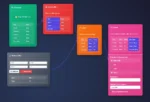Creating powerful visualizations with choropleth maps is both an art and a science that can unlock tremendous insights. Yet, the effectiveness of these maps hinges on selecting the right classification method. As strategists focused on data, analytics, and innovation at Dev3lop Consulting, we recognize the significance of clear, accurate, and insightful spatial representation. Decision-makers depend on choropleth maps to clarify intricate spatial patterns swiftly, turning vast datasets into understandable visuals that support informed decisions. This guide explores various classification methods for choropleth maps, highlighting their strengths, limitations, and how choosing the appropriate strategy can significantly affect the interpretation and impact of your data story.
Understanding Choropleth Map Classification
Before diving into the specifics, we should clearly understand what choropleth map classification entails. Choropleth maps visually represent quantifiable geographic data by assigning colors or shades to predefined regions based on numeric values. The classification method you choose plays a crucial role in both perception and interpretive accuracy. Every classification method segments your data into different groups or classes. Because each technique defines boundaries differently, it directly impacts visual representation, interpretation, and resulting business decisions.
For organizations looking to leverage geographic data effectively, precision in data classification is indispensable. Accurate classification assists stakeholders in clearly identifying trends, clusters, or anomalies—enabling smarter, data-driven decision-making. Aligning these efforts with strategic data engineering consulting services ensures efficient data integration, timely analytics, and robust data visualization processes across your organization.
Now, let’s compare and examine the most common classification methods—equal interval, quantiles, natural breaks (Jenks), and standard deviation—to clearly understand their ideal use cases and constraints. These comparisons help technical decision-makers navigate toward the optimal method depending on their data characteristics and analytical objectives.
Equal Interval Classification Method
Definition and Logic
The equal interval method divides data ranges equally by taking the entire range of data values—subtracting the smallest from the largest—and splits this difference into evenly spaced intervals. Thus, each range’s interval size is uniform, producing classes that span identical numeric intervals. This method offers intuitive readability since data class intervals are consistent, easy-to-understand numeric increments.
Pros and Cons
This method’s chief advantage is simplicity and interpretability. Decision-makers who want a straightforward linear interpretation of their data will find equal intervals appealing. It works best when data distributions are uniform or continuous across the value spectrum. However, problems arise when data distribution is skewed towards particular ranges, as numerous regions can fall disproportionately within certain classification ranges, resulting in potentially misleading maps. Data practitioners need to use this method carefully and apply it selectively—especially when dealing with big vs. small data scenarios, as the skewness might be amplified in smaller datasets and overlooked in larger ones.
Quantile Classification Method
Definition and Logic
The quantile classification aims to divide datasets into classes so each class has an equal number of observations or areas represented. Each group contains approximately the same count of geographic regions. The quantile method ensures that every class appears equally populated, making it highly effective for comparing datasets across regions and understanding relative rankings.
Advantages and Disadvantages
When precision is secondary to comparison and ranking across geographic areas, the quantile method shines. Its mechanism enables quick and direct comparisons, clearly framing higher and lower ranking geographic segments. However, as areas are equally represented, quantiles can be problematic when data is unevenly distributed across classes, leading to exaggerated similarities and differences. In these instances, thoughtful interpretation and clarity about the method’s limitations are vital. Further optimization, possibly through dataset sampling techniques for processing optimization, can help you better determine if this method aligns with your analytics goals.
Natural Breaks (Jenks) Method
Understanding Jenks Natural Breaks
Natural breaks, commonly known as Jenks optimization, is a method developed to minimize the variance within each class. It finds natural groupings inherent in the data and identifies breakpoints where substantial differences between data groups exist. This algorithmic classification naturally aligns with human perception, grouping homogenous clusters and highlighting significant distinctions between different groups.
Strengths and Limitations
This approach excels at translating real-world data distributions clearly and intuitively with higher analytical accuracy. However, unlike equal intervals or quantiles, Jenks classification is computationally more demanding, making it potentially problematic for large-scale datasets without appropriate data engineering frameworks. A thoughtful data infrastructure incorporating technologies like adaptive parallelism in data processing can mitigate the computational burden. Furthermore, given Jenks’ adaptive and algorithmic complexity, consistently replicating classification results over incremental dataset iterations can present difficulty. Nonetheless, when strategically employed, it creates maps that more accurately reflect complex datasets, fostering more informed, nuanced decision-making and communication.
Standard Deviation Classification Method
Concept Explained Clearly
The standard deviation method addresses classification by setting classes relative to statistical variance (standard deviation) measured from the dataset’s mean or average value. Each class range gets defined by how far observations deviate from the mean in positive or negative increments. This method excels in revealing contrasts and extremes in datasets, easily exposing regions profoundly deviating from normative benchmarks.
When and How Best to Apply It
This approach is particularly effective when your analysis focuses on identifying anomalies, outliers, or extremes regarding spatial variables, especially useful in well-understood industries having rigorous standard benchmarks. For instance, deployments in scenarios focused on healthcare analytics can greatly benefit—read about this example further in our article, how data analytics is transforming the healthcare industry. Yet, due caution is required; standard deviation loses effectiveness with strongly skewed data or datasets lacking normal distribution. Also, stakeholders might find standard deviation challenging to interpret clearly without comprehensive statistical guidance, emphasizing the necessity of robust analytic communication strategy.
Selecting the Right Classification Method for Your Analytics Project
Different classification methods serve unique analytical objectives, highlighting distinctive elements in spatial data. Selecting your method depends significantly on understanding your dataset’s distribution characteristics, analytical challenges at hand, and your audience’s interpretive needs. Considering these factors leads toward balanced classification method selection, avoiding inaccuracies and misinterpretations.
It’s advisable to leverage advanced data modeling techniques—feel free to explore further in our article why data modeling is the blueprint for data-driven success—to ensure accurate representation before classification. Proper modeling ensures data accuracy, better aligning your chosen classification method with nuanced decision-making processes.
The Connection Between Classification Methods and Data Processing Efficiency
Proper classification impacts not only insights and data accuracy but processing efficiency as well. Employing optimization strategies like projection pushdown in data access patterns can significantly enhance database performance, accelerating computation related to classification methods. Moreover, exploring innovative computational methodologies, such as leveraging the transformative power detailed in our coverage of quantum computing opportunities, prepares your organization to manage complex spatial analytics more swiftly.
Staying Compliant While Visualizing Data
Beyond analytics and performance, it’s crucial also to prioritize data privacy and comply strictly with evolving data regulations while handling spatial analytics data. Our primer on data privacy regulations and their impact on analytics highlights key areas of compliance needed before utilizing geographic data in visualizations. Adopting compliant measures preserves stakeholder trust, protects organizational integrity, and avoids legal complications frequently overlooked during map classification exercises.
Conclusion: Partnering on the Route to Data Visualization Excellence
Strategically using appropriate classification methods in choropleth maps significantly impacts how clearly your data translates into actionable insights. Understanding and articulating these methods while operating within rigorous compliance standards is essential. An experienced partner in data analytics and engineering can empower your journey towards data-driven visualization excellence more effectively. Explore Dev3lop Consulting’s innovative analytics solutions, proven strategies, and profound industry expertise, such as our impactful analytics initiative—improving transportation in Austin, Texas.
Ready to enhance your geographic data insights? Let’s build the future together.
Tags: Choropleth Maps, Data Analytics, Data Visualization, Classification Methods, Geographic Information Systems, Spatial Analytics
Thank you for your support, follow DEV3LOPCOM, LLC on LinkedIn and YouTube.

























